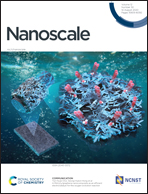Two unusual nanosized Nd3+-substituted selenotungstate aggregates simultaneously comprising lacunary Keggin and Dawson polyoxotungstate segments†
Abstract
Two unique nanosized Nd3+-substituted selenotungstates Na9K8{[W3Nd2(H2O)3(NO3)O6](B-α-SeW9O33)2(α-Se2W14O52)}·35H2O (1) and [H2N(CH3)2]7H9Na4{[W2Nd2(H2O)8O6(OH)2(β-Se2W14O52)][W3Nd2(H2O)6O7(B-α-SeW9O33)2]2}·84H2O (2) were prepared by reacting NaSeO3, Na2WO4·2H2O with Nd(NO3)3·6H2O in aqueous solution by controlling different cations and pH values. 1 was synthesized at pH = 4.3 in the presence of KCl, whereas 2 was synthesized at pH = 3.0 in the presence of [H2N(CH3)2]·Cl. The most striking structural feature of 1 and 2 is the coexistence of vacant Keggin and Dawson segments in the polyoxoanion, which is extremely rare in the field of polyoxometalate chemistry. The trimeric polyoxoanion of 1 can be perceived as a fusion of one α-type tetravacant Dawson [α-Se2W14O52]14− unit and two trivacant Keggin [B-α-SeW9O33]8− segments sealing a trigonal bipyramid pentanuclear [W3Nd2(H2O)3(NO3)O6]11+ cluster, while the pentameric polyoxoanion of 2 can be described as one β-type tetravacant Dawson [β-Se2W14O52]14− fragment and four trivacant Keggin [B-α-SeW9O33]8− segments anchoring a saddle-shaped [W8Nd6(H2O)20O20(OH)2]24+ cluster. In addition, the measurements of catalytic oxidation of aromatic thioethers show that 2 as a catalyst possesses extremely outstanding catalytic performance under mild reaction conditions.

- This article is part of the themed collection: 2020 Nanoscale HOT Article Collection


 Please wait while we load your content...
Please wait while we load your content...